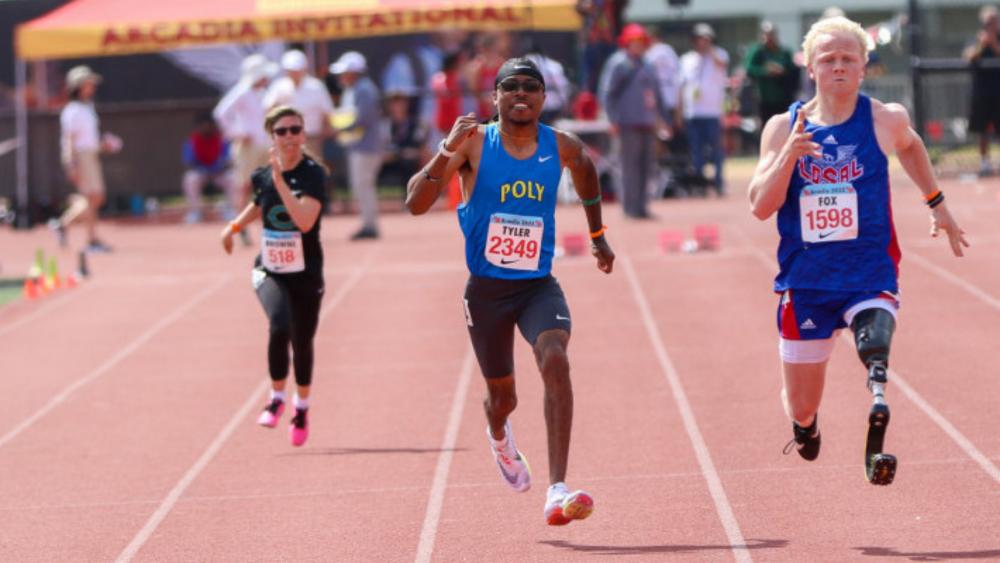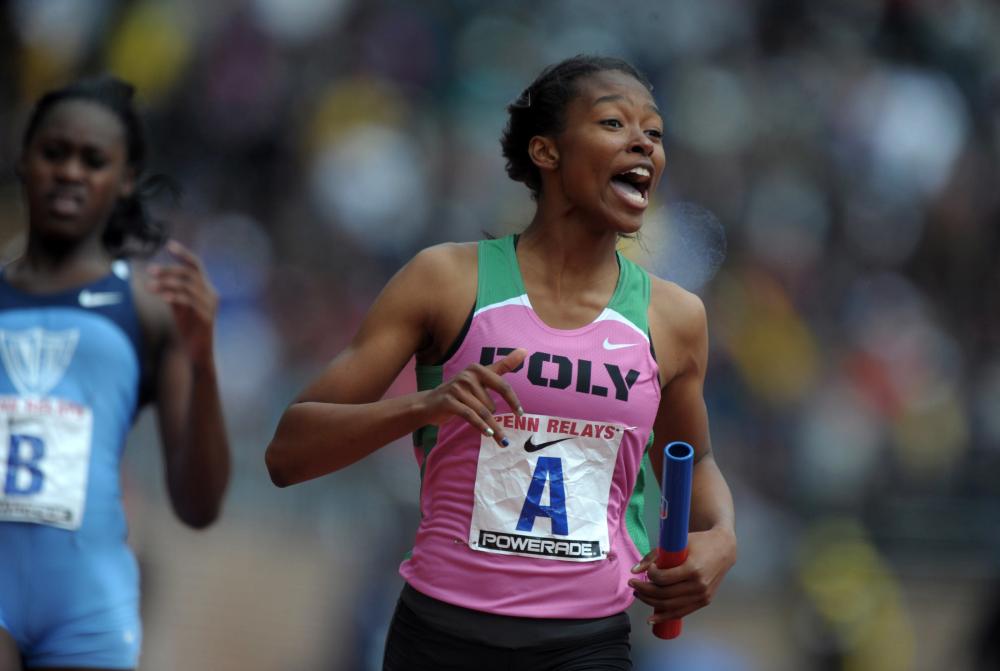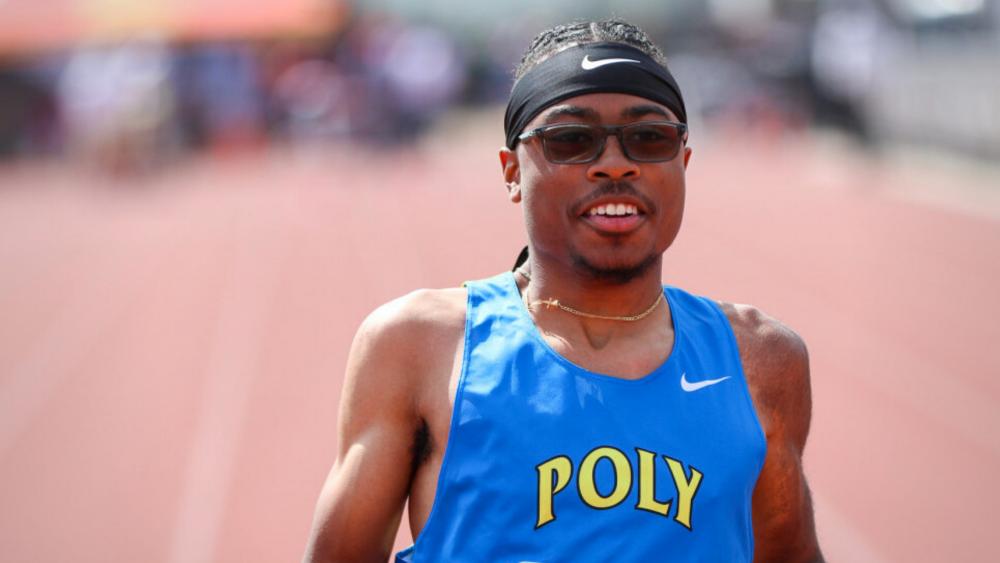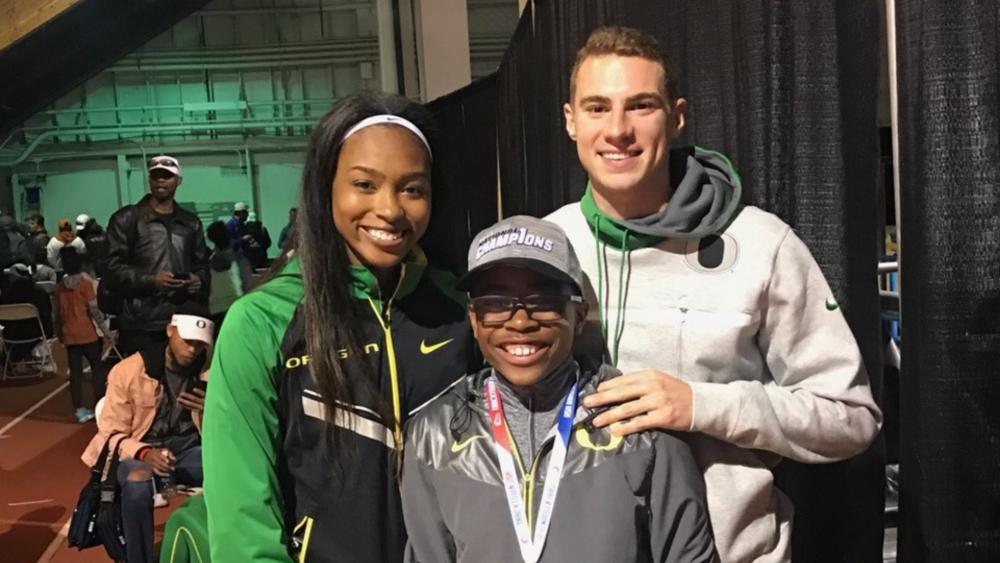Folders |
Gabe Tyler: Just Another JackrabbitPublished by
More Than 'Ari's Little Brother'A DyeStat story by Dave Devine Meet photos by Kirby Lee/Image of Sport and Ken Martinez ____________ Here’s Gabe Tyler, preparing to race. He’s pacing the lane line, shaking out his legs, scrutinizing his starting blocks. Making precise, almost fussy adjustments to the pedal spacing. Gauging the distance, the angles, the tightness of the set. Most sprinters do this, the assurance of a routine. He’s already listened to his pump-up soundtrack, a collection of walkout songs from his favorite WWE pro wrestlers. He’s performed his visualizations. Cleared his mind. Internalized the latest feedback from his coaches. Arms and legs at the same time. One motion. Out like a jet. His hair is in tight braids under a black Nike headband. He’s got his wristbands, his watch, his immaculate race day uniform. Swag, drip, fire ‘fit, however you want to say it — his coaches will tell you: when Gabe Tyler hits the oval, he’s always looking good. And across his chest, one of the most recognizable names in high school athletics, abridged from the formal designation — Long Beach Polytechnic High School — to the familiar, all-caps moniker: POLY. A California high school renowned for shaping teenage speedsters. And for Gabe, it’s not just the school name he’s standing on, he’s got pedigree on his side, too. His older sister, Ariana (Washington) Murphy, is an Olympian and a world champion in the 4x100 meter relay. His brother-in-law, Clayton Murphy, is an Olympic bronze medalist over 800 meters. There’s velocity in the family. And now Gabe is making his own mark on the track. Head clear, he waits for the familiar phrase: Runners to your mark. For most sprinters, it signals the continuation of the routine — more leg shake-outs, a gradual backing into the blocks, fingers bridged behind the starting line, body settled to stillness on a single knee — but for Gabe, there is a noticeable difference. He can’t settle his knee to the track. His race begins in the “set” position. That’s because Gabe’s legs are restricted by cerebral palsy. Once his spikes are pressed into the blocks, he’s unable to lower down. He is, by that point, already poised, muscles taut and ready to fire, shins parallel and quivering. When the second command arrives — Set! — hopefully without much delay, Gabe levers his hips a few painstaking inches higher, battles tight muscles, obstinate tendons and accumulated scar tissue, and waits for the pistol to sound.
Euna Washington was looking forward to nursing school graduation. With an 8-year-old daughter at home and a second child on the way, she was excited to collect her degree and continue a career in emergency medicine at Long Beach Memorial Hospital. There was every indication that plan would work out. Only 29 weeks into her pregnancy, Euna didn’t think she’d be having her baby for almost three months. But she never made it to the commencement. Gabriel Tyler was born on December 10, 2004, more than 10 weeks early and suffering a myriad of complications that can affect premature babies. “He wasn’t quite 3 pounds,” Euna recalls, “very tiny.” There were early concerns about his vision and mobility; doctors wondered if Gabe would ever be able to see or walk. He spent more than two months in the neonatal intensive care unit. Euna’s medical training gave her more insight than most into the challenges awaiting her son. “When it was time to bring him home after his two-and-a-half month stay,” she says, “I thought, ‘Something’s not right. My baby’s really stiff.’” The muscle and joint tightness she observed — also called spasticity — is a common indication of cerebral palsy, but Euna knew a diagnosis likely wouldn’t happen until Gabe began attempting to walk. When she brought him home from the NICU, she was finally able to introduce Gabe to her 8-year-old daughter, Ariana. The two hadn’t met sooner due to the hospital’s strict NICU visitation rules. Ariana has few memories of those early days with Gabe, but almost 18 years later, she can still recall being awoken for school by her aunt one morning, wondering where her mom had gone, and being told that her brother had come early. And then, how that confusing morning was followed by the long wait to meet Gabe, which seemed strange to her at the time. She didn’t fully comprehend the meaning behind her brother’s lengthy NICU stay. “It didn’t really register that he was different from other kids until way later,” Ariana says. “It made no difference to me — he was just my brother.” In the two-story condominium where they lived, the siblings shared a bedroom from the time Gabe was an infant. There was a bed and crib arrangement initially, and then a move to bunk beds, which lasted all the way until Ariana’s 2014 departure for college at the University of Oregon. Like all new babies in the house, especially to siblings, Gabe was noisy and needy at first; cute at times; annoying at others. As he grew older, and discovered novel ways to tease his sister, Ariana had her own ways of getting back at him. “He had these cute little blue plastic glasses with a strap,” she says, “and I always used to try to pop the strap on the back of his head.” Given the age difference, however, and Euna’s hectic emergency room schedule, Ariana more often found herself in maternal roles than engaged in sibling rivalry. She learned to change diapers and prepare bottles. She made breakfast for both of them on weekend mornings — usually pancakes — and brought the food upstairs to their bedroom where they’d huddle and watch TV together. Sometimes Ariana controlled the remote — “Gabe was into bad reality TV at a very young age,” she says, “because that’s what I wanted to watch,” — and sometimes her brother successfully lobbied for his choices. “Everyone always asks me now, ‘How do you know all these kids’ songs?’ And it’s like, I literally shared a room with my brother who’s 8 years younger than me, so I grew up watching all the Nick Jr. and Disney Channel shows.” Over the course of a decade, doctors performed three different surgeries designed to straighten Gabe’s legs and improve his mobility. Like most kids, he still connects major life events to corresponding years in school: one surgery in third grade, one in fifth grade, one in ninth. Each operation, and its subsequent recovery, brought a mixture of heartbreak and hope for Euna. She hated to see her son struggle, but marveled at his resilience. “He’s definitely a miracle,” she says, “a special child.” Once Ariana started high school at Long Beach Poly, where she soon developed into a top sprinter, Gabe tagged right along. Crystal Irving, Poly’s head boys’ and girls’ track coach, had a daughter a year younger than Gabe. Several Poly athletes also had siblings born around the same time, and some of the coaches had children close in age. There was, Irving recalls, “a host of track babies” continuously around the track in those days, cheering from the stands, playing tag on the turf or digging in the long jump pit after meets and practices. “All of them were acclimated into the track world as 2-, 3- and 4-year-olds,” Irving says, “hanging out at track meets while the big sisters or older brothers competed.” Gabe fit right in — sunning on the field, burrowing in the sand, loping around in oversized hand-me-down Poly sweatshirts — but also joining Euna, Ariana and the Poly faithful on trips to the Armory in New York City and the Penn Relays in Philadelphia. He quickly endeared himself to Ariana’s teammates, always ready with a hug or a high five after a race. Euna remembers one Poly practice when Gabe was recovering from an operation, and she spotted him being propelled around the oval by Ariana and her friends. “They literally had a field day pushing him around the track in his wheelchair,” Euna says. “Like, actually running with him. And he was laughing the whole way. So, yes, we always just brought him along; he was part of that team.” Around her track obligations, Ariana continued embracing the role of maternal big sister. After Gabe’s surgeries, it was Ariana who would carry him up and down the condo stairs. And when Euna had to leave at 6:30 a.m. for shifts at the hospital, it was Ariana who made sure Gabe got on the bus, even if it meant arriving late for school herself. No surprise then, that during Ariana’s final year at Poly, a senior campaign in which she cemented her place as one of the greatest sprinters in California prep history with her third straight sweep of the 100- and 200-meter dashes at the CIF State Championship, 9-year-old Gabe was telling anyone who would listen that he wanted to be just like his sister. Become a sprinter on the Poly team? Of course. Compete at the CIF State Meet? Absolutely. Win a state title? Ari did, right? Eight times. So, why wouldn’t third-grade Gabe, who’d already overcome a series of leg surgeries and castings and braces, learned how to walk — twice — and absorbed everything there was to grasp about Poly’s long line of champions, think that he, too, could represent the Jackrabbits at the state meet?
In 2005, Sports Illustrated named Long Beach Polytechnic the “Sports School of the Century.” Among its alumni, the school counts a dizzying array of professional athletes and Olympians. In the sport of track and field specifically, the Jackrabbits — or Trackrabbits as they’re sometimes dubbed — have a reputation that extends far beyond the West Coast. The boys’ and girls’ teams have claimed numerous national titles and all-time marks, including four current U.S. high school relay records. Names like Shana Woods, Shalonda Solomon, Bryshon Nellum, Myles Andrews and, yes, Ariana Washington, have elevated the Jackrabbits to royalty among U.S. high school track and field programs. So, in the fall of 2019, when Gabe told Euna that he planned to go out for the team at Poly, it made sense. He wanted to be part of the tradition he’d grown up around, but he also wanted to be taken seriously as an athlete. He’d competed in swimming, basketball and Little League through elementary and middle school, and saw no reason why track wouldn’t be the same — a sport in which he could excel. “I’ve always told him,” Euna says, “‘You know your limitations and you can do whatever you want. Don’t ever let anyone say you can’t do it.’ So, when he said he was going to run track, it was like, ‘That’s it, go for it.’” Gabe started training with the Jackrabbits that autumn, but two events in early 2020 derailed his freshman efforts: another leg surgery in January, and the arrival of COVID-19 in March. This third surgery was the one Euna and Gabe still refer to as “the big one,” requiring significant work to both lower limbs. On his right leg, Gabe’s orthopedic surgeon performed an operation known as an osteotomy of the femur: cutting the femur, or thigh bone, in half, removing a section, and then reassembling the bone and holding it together with metal rods. In Gabe’s left leg, surgeons inserted a pin in the femur to slow that leg’s growth. Asked whether he had to re-learn to walk — yet again — and then, eventually, to run, Gabe offers a terse, wincing response. “Yes, I did. And it was painful.” Only this time, Ariana wasn’t around to carry him up and down the stairs. Or to zip him, laughing, in his wheelchair around the track. “When I came home,” Gabe recalls, “I could only be in the wheelchair for an hour or two, and then my legs would start to hurt and I’d have to lay back in bed to relieve the pain.” Gradually, over the course of months, he returned to running. And then, once COVID restrictions eased, began practicing again with the Jackrabbits. But running, in the wake of that difficult third surgery, still felt fraught. His first day back was short-lived. “The second we started running,” he says, “my right leg began to hurt and it felt like I was going to fall and wouldn’t be able to get back up. I stayed on my feet, but I had to tell Coach Irving that I wasn’t going to be able to finish. It was hurting too much.” With a great deal of work by Gabe, and assistance from Irving and the other coaches, Gabe was able to begin competing in sprints again for Poly. Sophomore year, he recorded a personal-best 14.21 for the 100 at a meet in April. A month later, he won the Ambulatory 100-meter dash at the 2021 Arcadia Invitational. But even though the California Interscholastic Federation (CIF) had added wheelchair and ambulatory categories for state championship events in 2016 — a change Gabe needed in order to fulfill his dream — continuing COVID concerns led to the cancellation of the 2021 CIF state meet. Gabe would have to wait another year. In the meantime, he focused on continuing to improve as a sprinter. Cultivating his friendships on the team. Distributing hugs, as Coach Irving says, to the “honorary aunties and uncles” on the coaching staff. Realizing, as his legs grew stronger and his running became less painful, how much joy he derived from these connections. How much he appreciated being with people who loved this sport the way he did.
No wasted movement. That’s been Irving’s project with Gabe this season. It’s a result of something she noticed during his acceleration drills: Gabe would take off by driving his arms first, then allowing his legs to catch up. “As soon as your arms go,” she tells him, “I need your legs to go, too, everything in one motion, and shoot out of there like a jet.” Just as she and the other Poly coaches have done with all the athletes on the team — nearly 200 total — Irving drills Gabe on mechanics, form and efficiency. She’s helping him become more comfortable with those starts, too, and educating meet officials on the adjustments needed when Gabe is on the line. “We make them aware,” Irving says, “that on the ‘Set,’ they can’t hold him for up to three seconds like other athletes. They have to make a special accommodation. So, if you’re in the same heat as Gabe, you’re going to get a ‘Set’ and then the gun. No waiting.” Gabe appreciates that accommodation, he knows it’s necessary, but in general he wants to be treated like all the other Poly athletes. Same workouts, same feedback, same hopes for success. Irving recalls a day, shortly before the Arcadia Invitational last year, when Gabe approached to ask if he’d be issued one of the special Poly uniforms that runners receive for big invitationals. He remembered all the color variations Ariana sported, and was hoping for something equally flashy himself. Irving assured him that he’d be taken care of, she’d already pulled a uniform, and he’d look as sharp as all the other varsity athletes. “I said, ‘We got to make sure you look good, Gabe. Because when you look good, you run good.’” Several weeks later, when he finally had that opportunity to race at the CIF State Meet, it was the same arrangement — signature Poly uniforms, prelims and finals. Look good, run good. And although Gabe had never competed in front of a crowd as large as the one at Veteran’s Memorial Stadium in Clovis, he overcame his nerves to place fourth in both the 100- and 400-meter ambulatory events. The first Jackrabbit to ever contest in those events at a state meet. Ariana, no stranger to historic state meet achievements, badly wanted to be in California for Gabe’s post-season debut, but she was at home in Ohio — preparing for the birth of her first child. In 2019, Ariana married fellow Olympian Clayton Murphy; the two had met playing Uno in the athlete village at the 2016 Rio Games. In the fall of 2022, the couple welcomed a baby boy named Cash. Remarkably, Cash was also born early — Ariana hadn’t yet reached her third trimester — and endured a lengthy NICU stay before the Murphys were able to bring him home. And while Cash doesn’t appear to suffer any long-term effects from his premature birth, Ariana can’t help but feel echoes of Gabe’s birth and childhood in her own experience as a young mother. “I always tell people,” she says, laughing, “Gabe was like my first son.” And like any proud parent — or supportive big sister — she was thrilled when Gabe had the chance to represent Poly at the state meet. “It makes me really proud,” she says. “I tried to instill in him, not only through my words but with my actions, that you can do anything you put your mind to. Don’t ever let anyone tell you that you can’t do something. Don’t ever let anyone tell you that you’re less than.”
This isn’t a story about legs. It isn’t a story about brokenness or loss or incompleteness. And it’s certainly not a maudlin, inspirational tale about “overcoming” adversity, even though Gabe has done that in spades, over and over again. This is a story about belonging. Fitting in. Finding your people. It’s about that old, teenage tension between wanting to be extraordinary and wanting to be just like everyone else. That enduring, exasperating quandary: Standout? Or fade in? Gabe knows he stands out, but in many ways, he wants to be like all the other kids on the team — just another Poly runner. For years, he watched from the sidelines as the high school’s athletes competed; he analyzed their pre-race routines, studied their form, adopted their techniques. And when he competes now, he feels like he’s replicating that form. Executing those races. Flying down the track. “In my mind, when I run,” Gabe says, “I feel like I’m running how everyone else runs. But on camera, compared to everyone else, I’m running a completely different way.” For him, seeing those races on video is the most difficult part of the sport. “I don’t like it,” he says, “but —” He pauses, grasping for a word to capture the disconnect between how he feels running and how he appears on screen, settling for a classic adolescent catch-all, freighted with frustration: “So…yeah.” Stand out? Or fade into the crowd? On the Long Beach Poly team, he’s somehow able to do both. The prominence of the team, the attention the Poly name attracts, and his own efforts as an ambulatory athlete all nudge him into prominence. But the friendship of his teammates, the way they treat him like anyone else, the even-handed critiques from coaches — all of that allows him to recede from the spotlight. All of it provides, as Irving emphasizes, a home. A place where someone is waiting on you, expecting you, counting on you. “That sense of belonging,” the coach says, “is everything.” This year, for the first time, Poly’s annual Track-Rabbit Invitational included ambulatory events in the meet program. Irving added the events to honor Gabe’s determination, to provide an avenue for him to record qualifying marks for the state meet, and — perhaps most importantly — to expand the team’s efforts at inclusion. Gabe was deeply moved by the addition, and took full advantage, recording state-eligible marks for the 100-, 200- and 400-meter dashes. It means another trip to Clovis for the state meet in May. And this year, exactly nine seasons after watching Ariana soar to her third CIF sprint double, he’s hoping to claim a medal of his own. If he does, there’s a sense it will no longer be because he wants to be “just like Ari.” It will be because he wants to be Gabe. “I do think that he wants to separate himself from me,” Ariana says. “He doesn’t want to just be known as my little brother. He wants to make a name for himself, in whatever capacity that is. So, he is the first ambulatory runner from Poly, and it doesn’t really get more historic than that, to be the first.” Perhaps this will be Gabe’s legacy, as much as anything else. Opening people’s eyes to the importance of inclusion, helping to inspire opportunities for more kids to compete. Challenging the invisible, arbitrary lines that would attempt to define who gets to be an athlete, and who doesn't. “He embraces his disability,” Euna says, emphatically. “He doesn’t hide it, he doesn’t hide behind it. He tackles it head on, and he doesn’t think he’s any different than anyone else.” Extraordinary, yes, but also one of the guys. A standout sprinter…in a long line of Poly speedsters. Gabe the Great. And also — just another Jackrabbit. Which is exactly how he wants it. |












